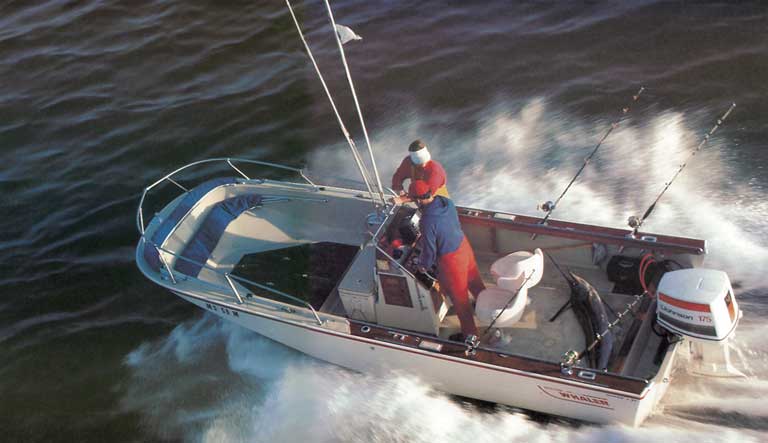
The 1978 Catalogue featured this overhead view of the Outrage V-20 returning from ocean fishing, emphasizing the offshore capability of the new boat.
Original Photo: Boston Whaler
DIMENSIONS (from 1979 Catalogue listings unless otherwise noted)
Length...................... 19 feet 10 inches
Beam........................ 7 feet 4 inches (or sometimes 5 inches)
Draft....................... 11 inches (with engine tilted clear of water)
Length to Beam Ratio........ 2.67:1
Deadrise Angle.............. 10.5-degrees (measured photographically)
Weight...................... 1500 pounds (later 1650 pounds, 1981 - 1985)
Swamped Capacity............ 4000 pounds
Persons Capacity............ 7 people (later 10 people)
Maximum Horsepower.......... 180-HP (initially 175-HP in some literature)
Minimum Horsepower.......... 85-HP (but shown to plane with 70-HP)
Recommended Shaft Length.... 25-inch single engine; 20-inch dual engine
Fuel Capacity............... 65-gallon plastic tank or 63-gallon aluminum
tank in accessible center deck cavity
HISTORY
Designer....................Bob Dougherty
First year offered..........1978
Last year offered...........1985
Color.......................1978 - 1985 Desert Tan
M.S.R.P.....................$ 6,880 in 1978 for Base boat
EQUIPMENT
Standard ................ Fiberglass console with windscreen and
hand rail; Fire extinguisher; Mechanical
steering; Navigation lights with custom
stern light; Bow bitt; Swivel seats (2)
at helm position; Stainless steel bow-rail;
Wiring panel; After quarter cleats (pr)--
recessed; Flush-mounted rod-holders (pr);
Rod racks--under gunwale; Storage Boxes-Forward.
Notable options...........Console rod-holders; Flying Top Set, includes
Shelter, Boot, Top, Boot, Windshield;
Aft Curtain; Weather Curtain Set, includes
Stbd. Curtain, Port Curtain, Drop Curtain;
Workboat Specifications; Bilge Pump; Compass;
Console Front Seat; Cooler Seat; Reversible
Pilot Seat; Stainless Steel Side Grab Rails;
Stainless Steel Stern Rails; Spring Line Cleats.
PERFORMANCE
Single Engine Twin Engine
70/75-HP = 28-MPH 2 x 40-HP = 30-MPH
85-HP = 32-MPH 2 x 50-HP = 34-MPH
115-HP = 36-MPH 2 x 65-HP = 38-MPH
140-HP = 39-MPH 2 x 85-HP = 44-MPH
150-HP = 42-MPH
175-HP = 49-MPH
The 1978 Outrage V-20 was Boston Whaler's first vee-hull boat. Introduced in 1977 by a flyer printed separately from the main catalogue, it was described as "a dramatic new modified-vee hull design that gives you all of the advantages of a smooth, soft, dry ride without sacrificing our famous stability." This boat continued the previously used "Outrage" name, but conspicuously included the "V" in the model. Whaler historian Tom W. Clark believes this was intended to emphasize the new hull form and the departure from prior designs.
The Outrage V-20 is a distinct model from a later boat, the Outrage 20 introduced in 1985 . The two are sometimes confused. The "V-20" designation is an important distinction to maintain when discussing these boats. Unfortunately, Boston Whaler themselves failed to always use "Outrage V-20" as a model name for this boat. After production of the Outrage 19 and Outrage 21 models stopped in c.1980, Whaler dropped the "V" designator in all their model names and began to refer to this boat simply as the Outrage 20. To avoid this confusion, we prefer to maintain the original name when making reference to this model, hence "Outrage V-20" will be used as a distinctive name, although boats of this design made from c.1980 to c.1985 carry only the "OUTRAGE 20" decal on their hulls.
The Outrage V-20 is an evolutionary break point at which the Boston Whaler hull departed from its earlier designs. Up to this point, all Boston Whaler hulls had a somewhat rounded bottom at the stern. The Outrage V-20 was the first from Boston Whaler to use a moderate-vee hull design. The vee-shape of the hull was carried right to the transom. The size of the twin sponsons used in earlier designs was significanly reduced. The sponsons became just small runners or strakes in the hull bottom. The Outrage V-20 also retained the familiar Boston Whaler "smirk", created by carrying the chine line of the runners upward and crossing under the bow.
In departing from their previous hull forms, Boston Whaler appeared to be cautious about adopting a "deep-vee" hull. The amount of deadrise in the vee-hull of the Outrage V-20 was very moderate, believed to be less than 12-degrees. As a comparison, deep-vee ocean racing boats, like the famous C. Ray Hunt designed Bertram MOPPIE, were using constant-deadrise vee-hulls with angles of 24-degrees. (The Hunt design firm also objects that their designs are not "constant deadrise" but instead contain a subtle change in angle. However, to the eye of most observers, the vee-hull's angle does appear to be virtually constant, and this term is often used to describe this general category of hull design.)
According to Larry Goltz, Bob Dougherty (the boat's designer) explained to him many years later that the goal of the Outrage V-20 hull was to maintain Boston Whaler's reputation for tremendous lateral stability that had been earned by the twin-sponson style hulls of earlier boats. However, the ride of the Outrage V-20 was not all that Whaler had been hoping for, and in a subsequent design, the larger Outrage 22, the deadrise was increased by several degrees.
Boston Whaler's own words belie that notion, however. They seemed pleased with the design. In their literature they boasted the V-20 as "a new generation of Whalers—soft riding in a chop, stable as a barn lying in the troughs, and able to track smoothly down the backs of big seas like it was on wires." However, the Outrage V-22 was designed shortly afterwards, and its hull has a clearly deeper vee along with other distinct changes.
The effect of the vee-hull deadrise angle can be described somewhat simplistically with these observations:
With a very moderate deadrise angle, the Outrage V-20 retained excellent lateral stability, but did not deliver the enhanced ride into head seas that other, deeper-vee hulls were able to provide. The hull was relatively easy to power onto plane.
The hull's maximum power rating was cited as both 175-HP and 180-HP. This may be explained by the motors available at the time. In this era, V6 outboards of 175-HP were available. This would account for the hull rating at that level. However, twin 90-HP also became an option, particularly for offshore use, and this may have caused the maximum horsepower rating to be increased to 180-HP.
Performance with the moderate vee-hull was good. The factory data showed that a 70-HP motor would get the boat on plane and run at 28-MPH. With a 175-HP single engine the boat would hit 49-MPH, quite a respectable speed in those days. And with twin 85-HP motors, an Outrage V-20 would hit 44-MPH.
There is anecdotal second hand reporting that when certain OMC motors were used on the Outrage V-20, transom wedges were needed to create enough engine tuck-in to prevent porpoising under some conditions. This was thought to be due to a lack of trim range in the motor. For some reason, a reputation of porpoising seems to dog the Outrage V-20, but it is not known if this is well-deserved. Several owners have remarked about it.
It should be noted that the Outrage V-20 preceded the Outrage V-22 hull. There are often comments about the 20-foot hulls being truncated versions of the 22-foot hulls, with the aft two feet gone missing, but this is not the case in the Outrage V-20. This boat came before the later V-22 Outrage, and the hull form is considerably different.
A wood locating diagram that shows the location of embedded wood reinforcements can be downloaded from the REFERENCE section.
The cockpit seems quite conventional by today's judgment, however it did introduce several features now seen as archetypical of a Boston Whaler. For example, the Outrage V-20 has teak capped gunwale boards, under-gunwale rod holders, and below deck cleats and hawsepipes. All these design elements are considered to be classic Whaler.
The size of the cockpit of an Outrage V-20 in the stern was not terrifically greater than that of the concurrent Montauk 17 or the later Outrage 18. Most of the additional space is provided in the forward cockpit. The initial promotional photograph showed a fighting chair installed there for deep sea fishing.
One feature lacking in the Outrage V-20 is the molded-in steps in the bow. Instead, optional storage boxes were offered for this area. Without the molded in steps, working in the boat's bow can be somewhat awkward. There is a large area of the bow which is curved sharply upward and affords no good footing. The refinement of the steps would come in other models.
The stern of the cockpit ended with the splash well dam which ran straight across the back of the boat. This same style for the splash well would be maintained in all other Outrage models, except (curiously) the 22-foot boat, which would have a curved and smaller central splash well.
The Outrage V-20 featured an integral fuel tank contained in a center cockpit cavity. At one time a 65-gallon fuel tank constructed from plastic was believed to have been used. Later the fuel tank was changed to a 63-gallon aluminum tank. An aluminum tank was used in David Hart's 1978 Outrage V-20. The vee-hull design was perfect for a central fuel tank. The tank could have a concave bottom, permitting fuel to collect in the deeper center portion of the tank. This design continues today. Earlier models of the Outrage had used saddle tanks located under the boat's gunwales. The central fuel tank was an improvement. By locating the tank on the boat's centerline, there would be no changes in lateral trim as fuel was withdrawn. In addition, the weight of the fuel was carried lower in the boat, and this acted to improve stability as well.
The Outrage 20 was presented as a boat that could be used for offshore fishing. All the initial catalogue photographs showed the boat being used for ocean fishing. A full set of weather canvas was also offered, making the boat useful in foul weather.
The Outrage V-20 hull was also used for the Revenge V-20. The Revenge series is an adaptation of the Outrage hulls in which a foredeck and windshield are added, and a dual console configuration is created, with the helm on starboard. For more information on Revenge models, see Cetacea Page 46.
The only application of this hull in the commercial product division was as the 1985 GUARDIAN 20. The Outrage V-20 was available with the optional workboat lay-up schedule, which produced a stronger and heavier hull.
 |
|
1978 Boston Whaler Outrage V-20 The 1978 Catalogue featured this overhead view of the Outrage V-20 returning from ocean fishing, emphasizing the offshore capability of the new boat. Original Photo: Boston Whaler |
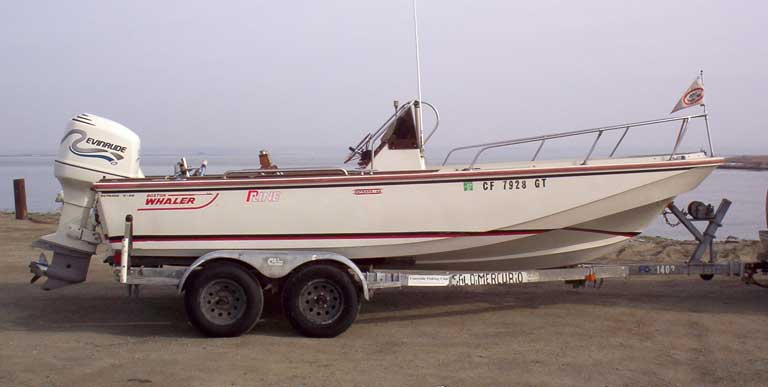 |
|
1979 Boston Whaler Outrage V-20 A well-preserved 1979 Outrage V-20 owned by Sal DiMercurio. It has been re-powered with a 200-HP Evinrude FICHT motor. Note the red rub rail insert. Photo Credit: Sal DiMercurio |
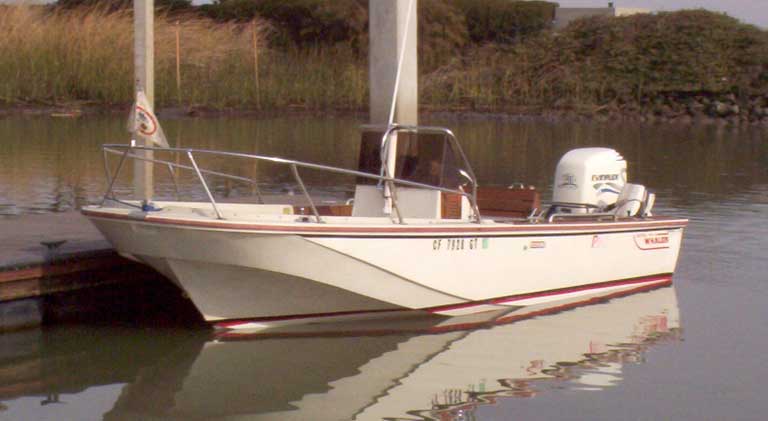 |
|
1979 Boston Whaler Outrage V-20 The static trim of the Outrage V-20 shows the slight bow-high characteristic often seen in classic Boston Whalers. Photo Credit: Sal DiMercurio |
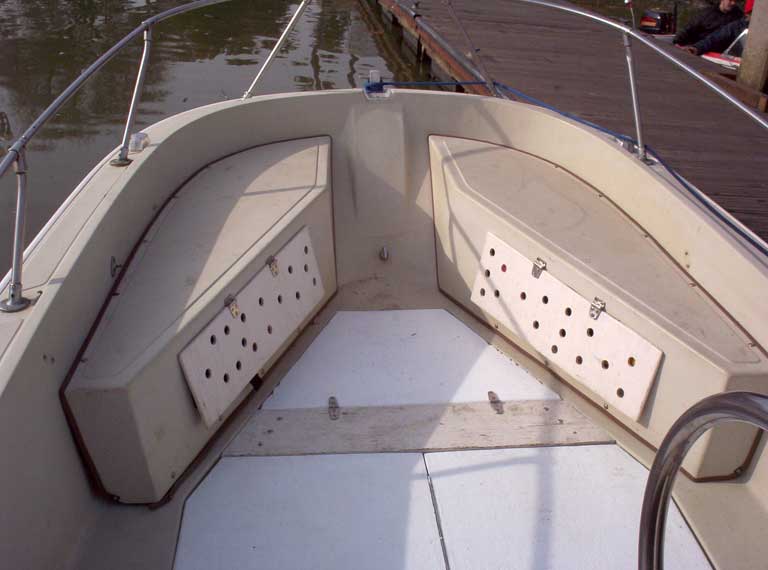 |
|
1979 Boston Whaler Outrage V-20 The foredeck of the V-20 did not have molded in steps. This boat has the optional bow storage boxes. The deck hatch covers are not original. The foredeck is raised several inches above the central and stern deck height. Photo Credit: Sal DiMercurio |
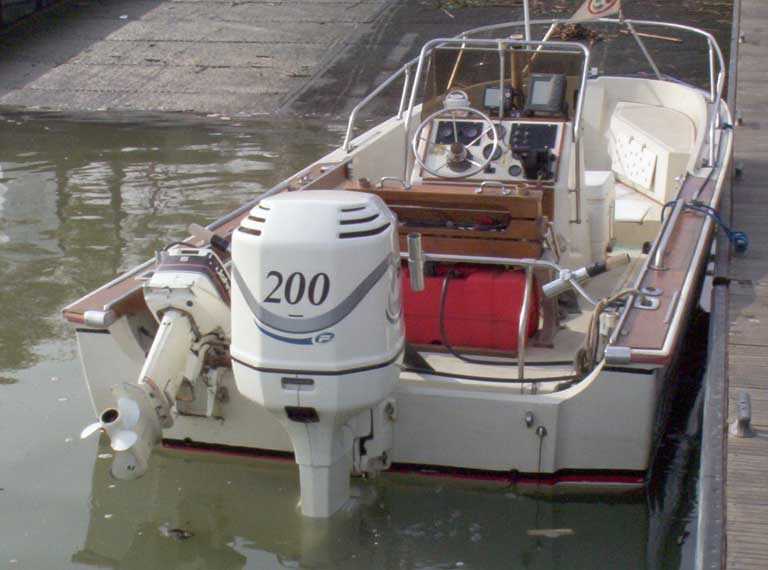 |
|
1979 Boston Whaler Outrage V-20 Transom view. This boat has a Reversible Pilot Seat, Bow Storage Boxes, and Stern Rails, all optional. The side rails are not original equipment. Photo Credit: Sal DiMercurio |
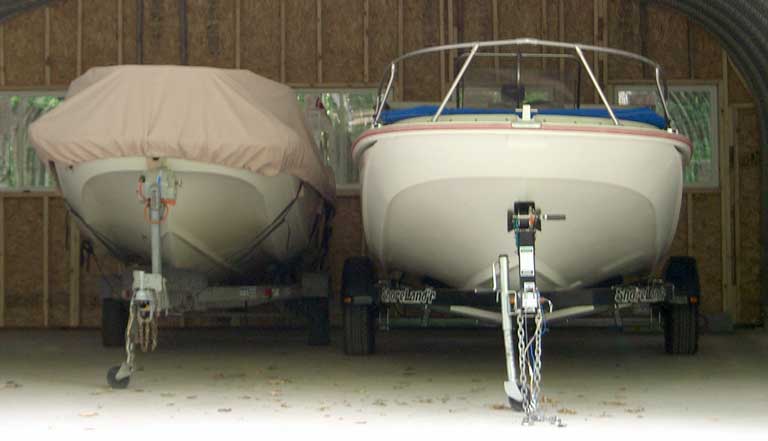 |
|
1978 Boston Whaler Outrage V-20 compared to Montauk 17 This view of a 1978 Outrage V-20 next to the smaller 1986 Montauk 17 show the relative size of these two boats. Photo Credit: David Hart |
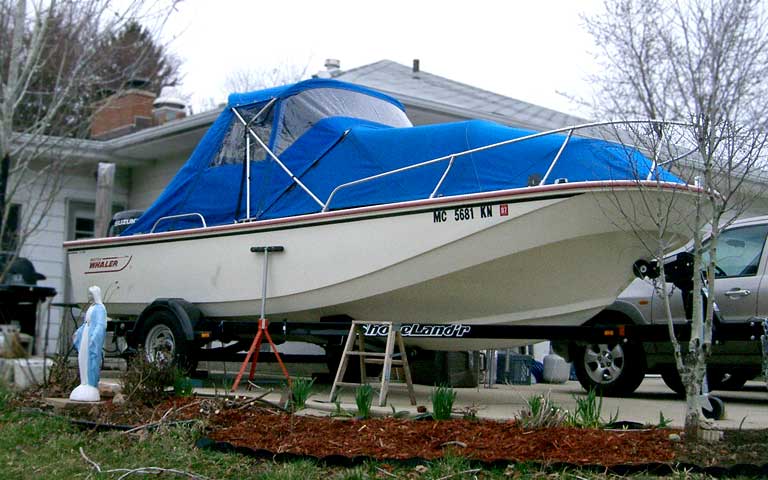 |
|
1978 Boston Whaler Outrage V-20 Canvas David Hart has this very well preserved 1978 Outrage V-20 fitted with a complete set of weather canvas. Boating in Michigan's upper peninsula probably makes good use of this weather protection. The boat has been re-powered with a Suzuki four-stroke DF115. The rub rail insert was originally red, but has now faded. The side rails and spring line cleats were options. Photo Credit: David Hart |
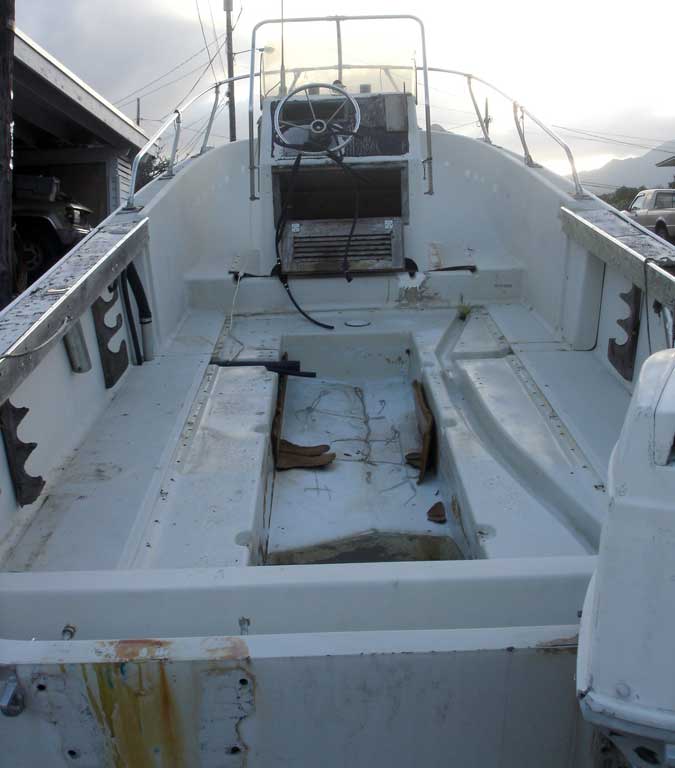 |
|
Boston Whaler Outrage V-20 Not all Outrage V-20 hulls are in pristine condition. This Hawaiian boat gives us an interesting look at the details of the hull's deck mold. Note that the fuel tank cavity is asymmetrical. The rigging tunnel bends inboard toward center to meet the center console. Photo Credit: Carson Perry |
The angle of the Outrage V-20 hull's deadrise has been reported by anecdotal recollection in the range of 10 to 12 degrees. Carson Perry took an nearly stern-on photograph of the transom of an Outrage V-20 which clearly shows the deadrise angle. By digitally rotating the image, I measured the hull's deadrise to be 10.5-degrees. There is some error in this because the photograph was not precisely orthogonal to the boat's keel. However, I would say the boat's actual deadrise is probably around 11 degrees. Photo-analysis of another view (not shown) of the Outrage V-20 transom also produced a measured deadrise of 10.5-degrees.
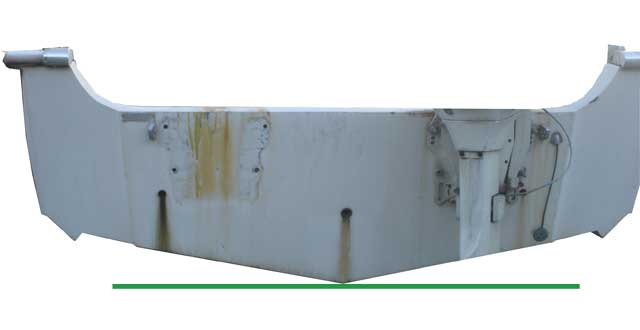 |
|
Boston Whaler Outrage V-20 The hull's shape at the stern is clearly seen in this cut-out view. By rotating this image digitally, I measured the deadrise as 10.5-degrees. The configuration of runners on the V-20 is different than in later evolutions of this design. The angle of the runners diverts more from the hull deadrise, and they may be slightly shallower than later vee-hull Boston Whaler boats. Photo Credit: Carson Perry |
Sal DiMercurio reports that "the V-20 is much faster than the newer Outrage 20's" and attributes this to the hull's flatter bottom and lighter weight.
"When I first got mine in 1985 it had a Johnson 140-HP and a 15-HP Johnson kicker. The engine was mounted all the way down on its lowest setting. The boat porpoised pretty good with almost any trim, mostly between 3,000 and 4,200-RPM. Anything over 4,500-RPM allowed me to trim with less porpoising.
"I raised the engine two sets of holes to the third set of holes, and the boat came alive with far better speed. The porpoising was reduced by at least half.
"[Later] I was able to get a 2000 Evinrude 200-HP FICHT. This engine puts out 222-HP to the prop. It is a bit heavy (510-lbs) for this boat. With an 80-pound 15-HP kicker back there, she sits a bit low at the stern. I make it a point to keep the load up front when on the ocean.
"She handles beautiful with the exception of slight porpoising if trimmed out and running around 3,500 to 4,500-RPM, but if I trim in just a bit, she levels out. Anything over 4,500-RPM allows me to trim to maximum with absolutely no porpoising. At wide-open-throttle and trimmed way out, the Outrage V-20 rides on maybe two or three feet of boat with no chine walking at all. I don't do much turning at WOT because this boat is just plain fast. She gets her best maximum speed in 18-inches of close chop on a cold day, as most all engines run best in cold weather.
"I have much experience on the sea, and it took me about six months to find the angles to run head-on in waves, the amount of trim to use in choppy weather, and what the best speed is in each situation. I find the Outrage V-20 runs smoother with a very light bow and plenty of throttle to hold her up, with plenty of air under her.
"If you run like this at a slower speed you will loose all your teeth. I have only been wet in that boat three times, and that was because of rain. If you don't take the time to learn how to handle this boat, you will pound yourself to pieces."
Sal also reports an observed top speed of his Outrage V-20 with 200-HP of just over 60-MPH under optimum conditions. It is anticipated that the Outrage V-20 will be more fuel efficient on plane than boats of similar size and weight with a deeper-vee hull.
David has a pristine 1978 Outrage V-20 as well as a 1986 Montauk 17. He says
"The Outrage is a whole lot bigger than the Montauk even though the room aft of the console (they both used the same console) is about the same. In the V-20 ...they didn't move the console forward to compensate. That may be the root cause of the infamous porpoising problem this model has. I fixed that with an Edge hydrofoil. The boat has a lot of bow area, enough to camp in."
David's boat has been re-powered with a 115-HP motor. This is indicative of how easily the Outrage V-20 can be driven due to its hull form. Even with this modest power it is a 36-MPH boat.
To Tom W. Clark, who assisted me with a wealth of historical documents on this model, I must extend my most sincere thanks. Also thanks to Sal DiMercurio, Carson Perry, and David Hart for their photographs and comments.
DISCLAIMER: This information is believed to be accurate but there is no guarantee. We do our best!
This article first appeared February 2007.
Copyright © 2007 by James W. Hebert. All rights reserved.
Unauthorized reproduction prohibited.
This is a verified HTML 4.0 document served to you from continuousWave
URI: http://continuouswave.com
Last modified:
Author: James W. Hebert